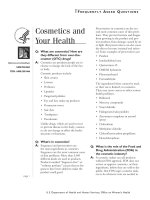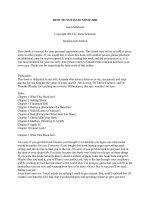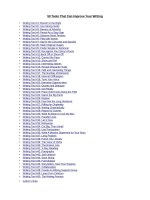Manage Your Writing potx
Bạn đang xem bản rút gọn của tài liệu. Xem và tải ngay bản đầy đủ của tài liệu tại đây (337.26 KB, 61 trang )
Version 3.0
by Kenneth W. Davis
Copyright © 1994, 2000, 2004 by Komei, Inc.
This work is licensed under the Creative Commons
Attribution-NonCommercial-NoDerivs License. To view a
copy of this license, visit
or send
a letter to Creative Commons, 559 Nathan Abbott Way,
Stanford, California 94305, USA.
You may read, copy, and distribute this book freely. In fact,
you are encouraged to do so! However, you may not alter
or sell it.
For the latest version of this book, for links to valuable
online resources, and to receive Manage Your Writing This
Week (a free weekly writing tip by e-mail), go to
www.ManageYourWriting.com.
This book is the basis for the much-expanded McGraw-Hill
36-Hour Course in Business Writing. For information, go
to
www.ManageYourWriting.com.
Manage Your Writing
Komei, Inc.
8910 Purdue Road
Suite 480
Indianapolis, IN 46268-1197 USA
2
Table of Contents
Introduction 4
Chapter 12: Manage Your Writing 6
Chapter 1: Find the “We” 12
Chapter 2: Make Holes, Not Drills 15
Chapter 3: Get Your Stuff Together 19
Chapter 4: Get Your Ducks in a Row 22
Chapter 5: Do It Wrong the First Time 26
Chapter 6: Take a Break and Change Hats 29
Chapter 7: Signal Your Turns 34
Chapter 8: Say What You Mean 40
Chapter 9: Pay by the Word 43
Chapter 10: Translate into English 46
Chapter 11: Finish the Job 54
Chapter 12: Manage Your Writing (again) 59
About the Author 60
3
Introduction
Manage Your Writing is a guide to a more effective, and
efficient, business writing process
.
This guide consists of thirteen chapters, covering twelve
steps in the writing process. Each of these twelve steps can
be thought of as taking five minutes in a typical one-hour
writing job. Therefore, they are numbered from 12 to 12,
like the numbers on the face of a clock.
The twelve steps in the writing process are grouped into
five stages:
Manage
• 12. Manage Your Writing
Plan
• 1. Find the “We”
• 2. Make Holes, Not Drills
• 3. Get Your Stuff Together
• 4. Get Your Ducks in a Row
Draft
• 5. Do It Wrong the First Time
Break
• 6. Take a Break and Change Hats
4
Revise
• 7. Signal Your Turns
• 8. Say What You Mean
• 9. Pay by the Word
• 10. Translate into English
• 11. Finish the Job
Manage (again)
• 12. Manage Your Writing (again)
You may go directly to any chapter. But if you wish to read
this book in order, please start with the first chapter,
Chapter 12. (Why Chapter 12? Because, remember, we’re
working our way around a clock face.)
5
Chapter 12: Manage Your
Writing
Take Charge of Your Writing
Process
In a cartoon I saw once, a Hollywood producer summons
his secretary. “I want to send a memo to the parking-lot
attendant,” he bellows. “Get me a couple of writers.”
I sympathize. Writing is not often easy or fun, and those of
us in business are usually too busy to give it the
time it
seems to demand. We’d all like to have staff writers on
call, to handle those difficult letters and memos that seem
to pile up.
Most of us, however—even in large organizations—have to
be our own “writing department.”
We have to take
personal responsibility for the stream of writing tasks
that cross our desks.
That’s probably as it should be. As entrepreneur Richard
Saul Wurman, president of Access Press, says, “You
shortchange yourself if you think that writing is ‘someone
else’s problem.’ . . . Even if your job description says
nothing about writing, by regarding yourself as a writer,
even privately, you can take advantage of the discipline of
the craft.”
What probably keeps most of us from regarding ourselves
as writers is the belief that the ability to write well is a
talent, or a gift. For some, it surely is: the great novelist,
poet, or playwright is doubtless born as much as made. But
6
the everyday business writing that you and I do—the
writing that gets the world’s work done—requires no
special gift.
It can be managed, like any other business
process.
Managing writing is largely a matter of managing time.
Writing is a
process, and like any process it can be done
efficiently or inefficiently. Unfortunately, most of us have a
pretty inefficient writing process. That’s because we try to
get each word, each sentence, right the first time. Given a
letter to write, we begin with the first sentence, thinking
about what to write, writing it, revising it, even checking its
spelling, before going on to the second sentence. In an hour
of writing, we might spend 45 or 50 minutes doing this
kind of detailed drafting, with only a few minutes of overall
planning at the beginning and only a few minutes of overall
revising at the end.
7
That’s like building a house by starting with the front door:
planning, building, finishing it—even washing the window
in it—before doing anything with the rest of the house. No
wonder most of us have so much trouble writing.
Efficient, effective writers take better charge of their
writing time; they
manage their writing. Like building
contractors, they spend time planning before they start
construction, and once they’re into construction, they don’t
try to do all the finishing touches as they go.
Many good writers break their writing process into
three main stages—planning, drafting, and revising—
with more time spent at the first and third stages than
8
at the second.
They also build in some “management” time
at the beginning and the end, and some break time in the
middle. To manage
your writing time, try the following
steps:
At the
managing stage (perhaps 2 or 3 minutes for a one-
hour writing job), remind yourself that writing
can be
managed, and that it’s largely a matter of managing time.
Plan your next hour.
At the planning stage (perhaps 20 minutes out of the hour),
• 1. Find the “we.” Define the community to which
you and your reader belong. Decide how you are
9
alike and different in knowledge, attitude, and
situation.
• 2. Make holes, not drills—as a consultant once told
Stanley Tool executives. That is, focus on the
outcome you want, not on the means you will use to
achieve it. Define your purpose.
• 3. Get your stuff together. Collect the information
you’ll use in your writing.
• 4. Get your ducks in a row. Organize your
information, so that you can give it to your reader in
the most useful order.
At the
drafting stage (perhaps 5 minutes out of the hour),
• 5. Do it wrong the first time. Do a “quick and dirty”
draft, without editing.
At the
break stage (perhaps 5 minutes),
• 6. Take a break and change hats. Get away from
your draft, even if for only a few minutes, and come
back with a fresh perspective—the reader’s
perspective.
At the
revising stage (perhaps 25 minutes),
• 7. Signal your turns. Just as if you were driving a
car, you’re leading your reader through new
territory. Use “turn signals” to guide your reader
from sentence to sentence.
• 8. Say what you mean. Put the point of your
sentences in the subjects and verbs.
• 9. Pay by the word. Make your sentences
economical.
• 10. Translate into English. Keep your words simple.
(Lee Iacocca put both these tips in one
10
“commandment of good management”: “Say it in
English and keep it short.”)
• 11. Finish the job. Check your spelling,
punctuation, and mechanics.
Finally, at the
managing stage again (2 to 3 minutes),
• 12. Manage your writing. Evaluate the process
you’ve just finished. Figure out how to improve it
next time.
So begin today to
manage your writing. As United
Technologies Corporation said in a
Wall Street Journal ad,
“If you want to manage somebody, manage yourself. Do
that well and you’ll be ready to stop managing and start
leading.”
11
Chapter 1: Find the “We”
Define Your Community—Writer
and Reader(s)
Most of us in business have heard the advice to make our
communication not “I”-centered but “you”-centered.
Business communication textbooks tell us to focus not on
the sender but on the receiver. They tell us to write not “I
will send you a check” but “You will receive a check.”
That advice is good. But it’s not good enough. It ignores
the fact that we in business are never isolated writers or
speakers communicating with isolated readers or listeners.
We communicate within organizations-ideally, within
communities. After all, the words
communication and
community both come from the same Indo-European roots
(
ko and mei, meaning “together” and “change”) (We named
our company, Komei, Inc., after this fact.) As Peter
Drucker says in his classic book,
Management, “There can
be no communication if it is conceived as going from the
‘I’ to the ‘Thou.’ Communication works only from one
member of ‘us’ to another.”
So the best business communication is not just “I”-
centered or “you”-centered. It is “we”-centered. To
make our letters, memos, and presentations more “we”-
centered, we can ask two questions.
The first question is “To what community do my audience
and I both belong?” Are we members of the same
department? Are we fellow shareholders of the same
company? Are we members of the same profession? In
short, what makes us “us”?
12
Try to find the smallest meaningful community that
answers this question. The newspaper
USA Today has
enjoyed great success with its “we”-approach, but
sometimes it has made its community too big: when we
read headlines like “We’re eating more kelp,” all us non-
kelp-eaters suddenly feel left out of the
USA Today
community.
If it helps, draw a circle on a piece of scratch paper. Label
it with the name of the community you share with your
audience. Then around that circle, draw circles for any
larger communities of secondary audience members. Will a
memo for your department, for example, also be read by
higher management outside the department?
Add to the diagram an arrow to represent your
communication. Are you bringing information into the
community from outside? Or are you simply moving
information from point to point within the community?
Then use your drawing as a visual aid as you start planning
your communication.
The second question is “How are my audience and I alike
and different?” As you answer this question, begin with
similarities and differences in
knowledge. Consider the
knowledge you share with your audience and the
knowledge you don’t share.
In today’s global marketplace, such consideration is more
important than ever. Several years ago, a large computer
company explained, in a software manual, the concept of a
“default value” in a program by comparing it with the
“usual” doughnut you get at your regular coffee shop—if
you don’t specifically request a muffin instead. A Japanese
representative for the company sent a memo back to
13
headquarters: “I have difficulty explaining to my customer
what is a doughnut and what is a muffin.”
Consider also your similarities and differences in
attitude.
What feelings about this communication do you and your
audience share? What feelings don’t you share? Some
writing and speaking is like paddling downstream, with the
current of your audience’s attitudes; some is like paddling
upstream, against the current.
Finally, consider the
circumstances in which you and your
audience find yourselves. If the communication is face to
face, the circumstances are obvious: the room, the lighting,
the acoustics, the time of day. But the circumstances of a
written communication are just as important. Will your
letter compete with 25 others on your reader’s desk
tomorrow? Or will it be the one letter your reader gets all
week?
As we begin to make our communication more “we”-
centered, we’ll find that
good communication not only
requires community; it
creates community. After all, the
words “We the People” created a community where none
existed before. “We”-centered communication helps us
follow Tom Peters’s advice, in
Thriving on Chaos, to
“pursue ‘horizontal’ management” and “involve everyone
in everything.” It helps us see ourselves and our readers or
listeners not as isolated blocks on a line-and-block chart but
as points in a network. In short, it helps us lead ourselves
and our organizations into the information age.
14
Chapter 2: Make Holes,
Not Drills
Define Your Purpose
A consultant once told the executives of a major tool
company, “You’re not in the business of making drills;
you’re in the business of making holes.”
Too many of us ignore that truth in our letters and
memos. We focus on the piece of writing—the tool—
itself, not on its purpose.
The result: our writing often
misses the chance to be as effective as it could be.
Mark McCormack, in
What They Still Don’t Teach You at
Harvard Business School
, writes that “business memos
usually have two purposes—either to project your ideas
onto the company or to protect you from other people’s
ideas. Make your choice before you write a word. Whether
you’re advancing your cause or defending your turf, you’re
readers won’t be clear about it unless you are.”
Malcolm Forbes said it too: “Over 10,000 business letters
come across my desk every year . . . . Here’s the approach
I’ve found that separates the winners from the losers (most
of it’s just good common sense)—it starts
before you write
your letter: Know what you want.”
As a sample, read this memo, to employees of a Fortune-
100 company:
In order to have effective controls on automobile
repairs and to insure proper and prompt payment of
15
invoices, all repairs and purchases of tires for
automobiles will be administered by Department
XXX, effective March 1, 19XX. Prior to taking your
automobile to a vendor for work, contact
Department XXX, extension XXXX, to obtain a
purchase order and release. Complete a blanket
purchase order release form with Department XXX
as department ordering and price is to be marked
advise; complete account code and department
charge, then obtain buyer’s signature.
Upon completion of form give a copy to the vendor
when you take the vehicle in for the service. After
the work has been completed check the bill to insure
there are no arithmetic or extension discrepancies
and verify that sales tax has not been included. On
the bill state that service has been received, then
have two signatures on the bill with the purchase
order and release order number. When the invoice
is correct and approved, send it to Department XXX
for processing.
If you have any questions, please contact me.
Thanks for your assistance in this matter.
If you made it through that, congratulations! If not, you’re
like most employees of the company. The memo didn’t get
its job done, mostly because the writer was working at
making a drill, not making a hole.
If the writer had thought about his or her
purpose, he or she
might have realized that it was to get employees to comply
with a new policy. How to get that compliance? By making
it as easy as possible.
16
Perhaps what the company needed was not a drill—a policy
memo—at all, but something else that would have made a
better hole. Perhaps a new form, in pads for the glove
compartment of company cars, with directions built in. But
short of that, the memo still could have achieved its
purpose better by stating that purpose more clearly and by
putting the steps in a numbered list.
One of my clients, an insurance CEO, was concerned about
the poor quality of memos coming across his desk. Their
problem wasn’t misspelling or bad grammar. It was an
overall lack of clarity. He scheduled a series of meetings
with his senior staff.
As a result of those meetings, the company adopted, on a
trial basis, a new memo form. Gone is the familiar
“Subject” line—a label that began solely for filing purposes
and that positively
invites vagueness. In its place is a
“Purpose” line, with two choices:
Purpose:
[ ] to tell you about:
[ ] to ask you to:
The writer checks either or both of these purposes and fills
in the blank or blanks.
For the writer, the new form demands that the “hole,” not
just the drill, be considered, right at the beginning of the
writing process. If the writer of the automobile memo had
used this form, he or she might have checked both
purposes, and written:
17
Purpose:
[x] to tell you about: the new auto-repair policy
[x] to ask you to: do the following steps when you
need repairs or tires
A better memo would surely have followed.
The new form also helps the reader. When you get a memo
on the form, you know right up front whether you’re just
being told
about something or being asked to do something.
You can decide immediately whether to read the rest of the
memo or set it aside. If you read it, you can read it with the
purpose in mind.
Shortly after we designed the memo form, Mark
McCormack’s
What They Still Don’t Teach You in Harvard
Business School
appeared, with a list of the eight
“toughest” messages to deliver: “(1) This is how you do it.
(2) I want to sell you. (3) I goofed. (4) I have some bad
news for you. (5) I did a great job. (6) Dear Boss, you’re
wrong. (7) This is my demand. (8) This is how you rate.”
McCormack continues, “I would read a memo that began
with any one of these sentences.”
Try it. Try stating your purpose as the first sentence in the
draft of your next memo or letter. Even if you later decide
that’s not the best time to say it, at least you’ll have thought
about your purpose. The rest of the memo or letter is bound
to be more effective.
You’ll be making holes, not drills.
18
Chapter 3: Get Your Stuff
Together
Collect Your Information
I know it’s happened to you. You’ve bought something that
needs assembling: a swing set or a ceiling fan or a
bookcase. An hour’s work, tops. But the instructions are
badly written, so you don’t read them all. Instead you just
start working. Soon you discover that you need a tool or
part that you don’t have, so work stops while you make a
trip to a hardware store. An hour later you’re back on the
job, and it happens again. Again you stop work to go buy
what you need. The one-hour job stretches into three or
four.
I know it’s happened to you because it’s happened to me.
And it happens to most of us when we
write. We jump into
writing memos and letters without making sure that we
have the materials—the information—that we need. So we
keep interrupting our writing to find that information. As a
result, the job takes longer and the writing is less effective.
We need to learn to get our stuff together before we start.
The information for a piece of writing can come from two
places: outside your mind, the stuff you don’t know yet;
and inside your mind, the stuff you already know. The
outside information can come from other people or from
written sources. For information from other people, learn
good interviewing techniques. Especially, follow the advice
of Warren Bennis and Burt Nanus in their book
Leaders:
The Strategies for Taking Charge
: “Successful leaders, we
have found, are
great askers, and they do pay attention.”
19
To be a “great asker,”
learn to ask “W and H” questions,
not “yes-no” questions:
ask questions that begin with
Who, What, Where, When, Why, and How. And then pay
attention to the answers; don’t be so busy thinking of your
next question that you don’t listen to the information you’re
getting.
For information from written sources, learn to be a good
user of libraries and other databases. An excellent book on
finding such information is Alden Todd’s
Finding Facts
Fast, published by Ten Speed Press.
Build an efficient personal library; keep close to your desk
the books and files you find yourself consulting often. The
books might include a dictionary, a one-volume
encyclopedia, an atlas, an almanac, and the specialized
reference books of your business or profession. More and
more reference books, of course, are available in computer-
readable form, on disk or on CD-ROM.
Also post prominently at your desk the phone number of
the reference department of your local public or university
library. Reference librarians can supply a great amount of
information for free, over the phone.
Other information is inside your mind, facts you already
know. It’s still important to get this information together
early in the writing process. Again, ask the basic “W and
H” questions and jot down your answers. Also ask the
following four pairs of questions about the subject of your
memo, letter, or report:
• How is my subject like others? How is it different
from others?
• Of what larger whole is my subject a part? Into what
parts can my subject be divided?
20
• In what time or times does my subject exist? In
what
space or spaces?
• What is the cause or causes of my subject? What is
the effect or effects?
But whatever means you use,
get your stuff together
before you start drafting.
Then your one-hour assembly
job can be done in an hour, with much more effective
results.
21
Chapter 4: Get Your
Ducks in a Row
Organize Your Information
In an early episode of the M*A*S*H television series, an
unexploded bomb lands in the compound. Hawkeye and
Trapper are assigned to defuse it. Radar locates a bomb-
defusing manual, and Colonel Blake, safely behind a
sandbag bunker, reads it aloud through a bullhorn.
“First you need a wrench,” he reads. Hawkeye and Trapper
find one. “All right, now, place it gently on the nut just
above the locking ring and loosen.” They do. “Now, rotate
the locking ring counterclockwise.” They figure out which
way is counterclockwise and rotate it. “Now, remove the
tail assembly.” They do. “And carefully cut the wires
leading to the clockwork fuse at the head.” Snip. Snip. “But
first, remove the fuse. . . .”
The resulting explosion dramatizes one of the toughest
things about communication: language is
linear. That is,
language is made up of one word, phrase, or sentence after
another. It’s usually read or heard in a “straight line,” from
beginning to end. Thought, on the other hand, is usually not
linear. When we know about something, we know it “all at
once,” as a network of simultaneous, interconnected ideas.
Changing this nonlinear thought into linear language is
one of the most difficult and important steps in the
communication process.
22
The writer of the bomb-defusing manual knew the subject
but didn’t consider the order in which readers would be
reading it. The result was—to say the least—a less than
effective piece of writing. An effective piece of writing is
organized: it presents its information in the order that best
serves the writer’s purpose and the reader’s needs.
Fortunately, most of us don’t have to write life-and-death
instructions. But attention to organization can help even our
routine messages. Consider this memo, from a
Fortune-100
company:
SUBJECT: Roadway identification in parking lots
During our Safety Coordinators’ meeting, the point
was made that with our energy conservation
program (during the hours of darkness, fog, etc.)
roadway identification in our parking lots is
hazardous. The recommendation was raised that we
might use a fluorescent-type reflecting paint. Would
you please investigate the feasibility of this
recommendation and advise me as to your decision
on implementation?
Your early response is appreciated.
That’s not a terrible memo. But if you’re like most people,
you had to read it at least twice to make sense of it. That’s
because the writer—like the writer from
M*A*S*H—seems
to have put the information down in the order he or she
thought of it, not in the order you can
use it.
After reading the first and second sentences of the memo,
you had no idea how to use that information, so you had to
dismiss it and keep on reading. Only with the third sentence
did you know what to do. By that time, however, you’d
23
forgotten what the first two sentences said. So you had to
read them again.
Here’s my suggested revision. It may not be a perfect
memo, but it at least gives information in an order you can
use it—an order more likely to get results:
SUBJECT: Fluorescent paint in parking lots
Could we use fluorescent reflecting paint in our
parking lots to make traffic lanes easier to see?
During our Safety Coordinators’ meeting, someone
pointed out that with our reduced lighting, roadway
identification is difficult when it’s dark or foggy.
Please find out whether this solution will work, and
let me know within a week.
Thanks.
While this kind of reorganizing can be done at the revising
stage of the writing process, that’s a little like changing the
floor plan of a house after you’ve built it. Organizing your
information is best done at the planning stage of the writing
process. For most letters and memos, you’ll need only a
minute or two to decide what information your reader
should get first, second, third.
By taking that minute or two to “get your ducks in a row,”
you’ll be doing your reader a great service. And you’ll also
be making the communication process easier for you.
When you have decided in advance what the main sections
of your piece of writing will be and in what order they will
come, you won’t have to interrupt your drafting to make
those decisions. And because you have divided your task
24
into parts, you will have turned a long, complicated writing
job into several shorter, simpler ones. You can write your
letter, memo, or speech one section at a time.
In this information age, organizing your communication
is more important than ever. John Naisbitt states the
problem in
Megatrends: “We are drowning in information
but starved for knowledge.” Software entrepreneur Neil
Larson offers the solution: “Knowledge is information with
structure.”
25









